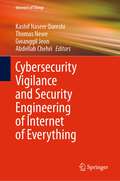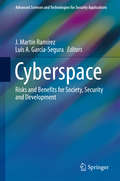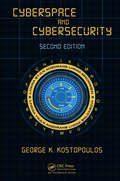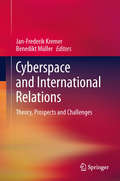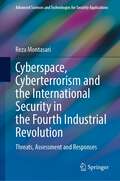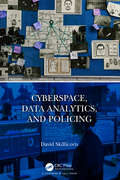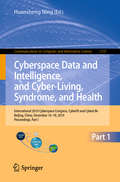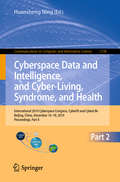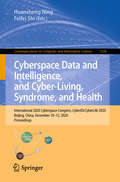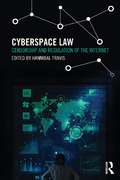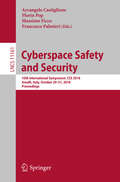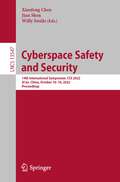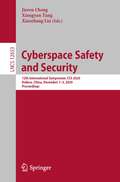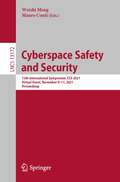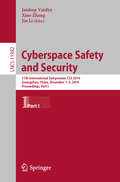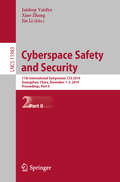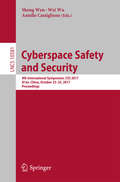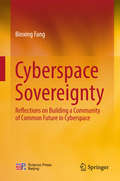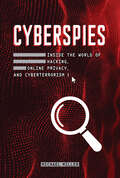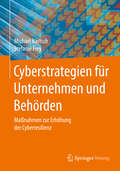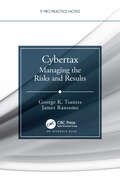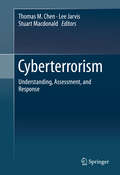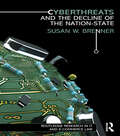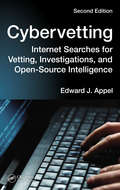- Table View
- List View
Cybersecurity Vigilance and Security Engineering of Internet of Everything (Internet of Things)
by Kashif Naseer Qureshi Thomas Newe Gwanggil Jeon Abdellah ChehriThis book first discusses cyber security fundamentals then delves into security threats and vulnerabilities, security vigilance, and security engineering for Internet of Everything (IoE) networks. After an introduction, the first section covers the security threats and vulnerabilities or techniques to expose the networks to security attacks such as repudiation, tampering, spoofing, and elevation of privilege. The second section of the book covers vigilance or prevention techniques like intrusion detection systems, trust evaluation models, crypto, and hashing privacy solutions for IoE networks. This section also covers the security engineering for embedded and cyber-physical systems in IoE networks such as blockchain, artificial intelligence, and machine learning-based solutions to secure the networks. This book provides a clear overview in all relevant areas so readers gain a better understanding of IoE networks in terms of security threats, prevention, and other security mechanisms.
Cyberspace: Risks and Benefits for Society, Security and Development (Advanced Sciences and Technologies for Security Applications)
by Luis A. García-Segura J. Martín RamírezThis book covers many aspects of cyberspace, emphasizing not only its possible ‘negative’ challenge as a threat to security, but also its positive influence as an efficient tool for defense as well as a welcome new factor for economic and industrial production. Cyberspace is analyzed from quite different and interdisciplinary perspectives, such as: conceptual and legal, military and socio-civil, psychological, commercial, cyber delinquency, cyber intelligence applied to public and private institutions, as well as the nuclear governance.
Cyberspace and Cybersecurity (Second Edition)
by George KostopoulosProviding comprehensive coverage of cyberspace and cyber security, this textbook not only focuses on technologies but also explores human factors and organizational perspectives and emphasizes why asset identification should be the cornerstone of any information security strategy. Topics include addressing vulnerabilities, building a secure enterprise, blocking intrusions, ethical and legal issues, and business continuity. Updates include topics such as cyber risks in mobile telephony, steganography, cyber security as an added value, ransomware defense, review of recent cyber laws, new types of cyber crime, plus new chapters on digital currencies and encryption key management.
Cyberspace and International Relations: Theory, Prospects and Challenges
by Jan-Frederik Kremer Benedikt MüllerCyberspace is everywhere in today's world and has significant implications not only for global economic activity, but also for international politics and transnational social relations. This compilation addresses for the first time the "cyberization" of international relations - the growing dependence of actors in IR on the infrastructure and instruments of the internet, and the penetration of cyberspace into all fields of their activities. The volume approaches this topical issue in a comprehensive and interdisciplinary fashion, bringing together scholars from disciplines such as IR, security studies, ICT studies and philosophy as well as experts from everyday cyber-practice. In the first part, concepts and theories are presented to shed light on the relationship between cyberspace and international relations, discussing implications for the discipline and presenting fresh and innovative theoretical approaches. Contributions in the second part focus on specific empirical fields of activity (security, economy, diplomacy, cultural activity, transnational communication, critical infrastructure, cyber espionage, social media, and more) and address emerging challenges and prospects for international politics and relations.
Cyberspace, Cyberterrorism and the International Security in the Fourth Industrial Revolution: Threats, Assessment and Responses (Advanced Sciences and Technologies for Security Applications)
by Reza MontasariThis book represents an interdisciplinary academic endeavour intended to provide readers with a comprehensive, balanced, and nuanced examination of critical issues at the intersection of cyberspace, cyberterrorism, and national and international security. It draws insights from a range of diverse fields, including Computer Science, Social Science, Political Science, International Relations, Criminology, and Law. Furthermore, the book investigates the field of Artificial Intelligence (AI) and related technologies, exploring their dual role in this dynamic landscape of contemporary cyberthreats, with both constructive and malicious implications.The book comprises four distinct themes, with each theme represented by a dedicated Part. Within this organisational framework, each overarching theme is systematically explored through a series of chapters, providing readers with a clear and thematic roadmap for their journey through the content.Part I, Understanding Terrorism and Counter-Terrorism Strategies, of the book explores complexities surrounding contemporary global security challenges. It serves as the foundational segment of the book, consisting of three chapters that critically analyse various dimensions of terrorism and the strategies implemented to combat it.Part II, Cyberterrorism Landscape, of the book offers an in-depth assessment of the current cyberterrorism landscape. This section comprises two critical chapters, each contributing to a comprehensive understanding of the contemporary threats posed by cyberterrorism and their implications for national security.Part III, Countering Cyberterrorism with Technology, of the book forms the core of the book’s exploration into leveraging technology to mitigate the threats of cyberterrorism. This section includes four critical chapters, collectively providing an in-depth understanding of the intersection between technology and counterterrorism strategies.Part IV, Artificial Intelligence and National and International Security, of the book delves into the complex relationship between AI technology and the broader security landscape. Comprising three pivotal chapters, this section provides a detailed understanding of AI’s transformative role in shaping the future of national and international security.This comprehensive resource serves as a valuable reference for law enforcement, policymakers, cybersecurity experts, researchers, academics, and technology enthusiasts interested in counter-terrorism efforts. By exploring the intricate landscape of cyberspace, this book equips readers with knowledge essential to addressing the evolving challenges posed by cyber terrorism.This comprehensive resource serves as a valuable reference for law enforcement, policymakers, cybersecurity experts, researchers, academics, and technology enthusiasts interested in counter-terrorism efforts. By exploring the intricate landscape of cyberspace, this book equips readers with knowledge essential to addressing the evolving challenges posed by cyber terrorism.This comprehensive resource serves as a valuable reference for law enforcement, policymakers, cybersecurity experts, researchers, academics, and technology enthusiasts interested in counter-terrorism efforts. By exploring the intricate landscape of cyberspace, this book equips readers with knowledge essential to addressing the evolving challenges posed by cyber terrorism.This comprehensive resource serves as a valuable reference for law enforcement, policymakers, cybersecurity experts, researchers, academics, and technology enthusiasts interested in counter-terrorism efforts. By exploring the intricate landscape of cyberspace, this book equips readers with knowledge essential to addressing the evolving challenges posed by cyber terrorism.This comprehensive resource serves as a valuable reference for law enforcement, policymakers, cybersecurity experts, researchers, academics, and technology enthusiasts interested in counter-terrorism efforts. By exploring the in
Cyberspace, Data Analytics, and Policing
by David SkillicornCyberspace is changing the face of crime. For criminals it has become a place for rich collaboration and learning, not just within one country; and a place where new kinds of crimes can be carried out, and a vehicle for committing conventional crimes with unprecedented range, scale, and speed. Law enforcement faces a challenge in keeping up and dealing with this new environment. The news is not all bad – collecting and analyzing data about criminals and their activities can provide new levels of insight into what they are doing and how they are doing it. However, using data analytics requires a change of process and new skills that (so far) many law enforcement organizations have had difficulty leveraging. Cyberspace, Data Analytics, and Policing surveys the changes that cyberspace has brought to criminality and to policing with enough technical content to expose the issues and suggest ways in which law enforcement organizations can adapt. Key Features: Provides a non-technical but robust overview of how cyberspace enables new kinds of crime and changes existing crimes. Describes how criminals exploit the ability to communicate globally to learn, form groups, and acquire cybertools. Describes how law enforcement can use the ability to collect data and apply analytics to better protect society and to discover and prosecute criminals. Provides examples from open-source data of how hot spot and intelligence-led policing can benefit law enforcement. Describes how law enforcement can exploit the ability to communicate globally to collaborate in dealing with trans-national crime.
Cyberspace Data and Intelligence, and Cyber-Living, Syndrome, and Health: International 2019 Cyberspace Congress, CyberDI and CyberLife, Beijing, China, December 16–18, 2019, Proceedings, Part I (Communications in Computer and Information Science #1137)
by Huansheng NingThis two-volume set (CCIS 1137 and CCIS 1138) constitutes the proceedings of the Third International Conference on Cyberspace Data and Intelligence, Cyber DI 2019, and the International Conference on Cyber-Living, Cyber-Syndrome, and Cyber-Health, CyberLife 2019, held under the umbrella of the 2019 Cyberspace Congress, held in Beijing, China, in December 2019. The 64 full papers presented together with 18 short papers were carefully reviewed and selected from 160 submissions. The papers are grouped in the following topics: Cyber Data, Information and Knowledge; Cyber and Cyber-enabled Intelligence; Communication and Computing; Cyber Philosophy, Cyberlogic and Cyber Science; and Cyber Health and Smart Healthcare.
Cyberspace Data and Intelligence, and Cyber-Living, Syndrome, and Health: International 2019 Cyberspace Congress, CyberDI and CyberLife, Beijing, China, December 16–18, 2019, Proceedings, Part II (Communications in Computer and Information Science #1138)
by Huansheng NingThis two-volume set (CCIS 1137 and CCIS 1138) constitutes the proceedings of the Third International Conference on Cyberspace Data and Intelligence, Cyber DI 2019, and the International Conference on Cyber-Living, Cyber-Syndrome, and Cyber-Health, CyberLife 2019, held under the umbrella of the 2019 Cyberspace Congress, held in Beijing, China, in December 2019. The 64 full papers presented together with 18 short papers were carefully reviewed and selected from 160 submissions. The papers are grouped in the following topics: cyber data, information and knowledge; cyber and cyber-enabled intelligence; communication and computing; cyber philosophy, cyberlogic and cyber science; and cyber health and smart healthcare.
Cyberspace Data and Intelligence, and Cyber-Living, Syndrome, and Health: International 2020 Cyberspace Congress, CyberDI/CyberLife 2020, Beijing, China, December 10–12, 2020, Proceedings (Communications in Computer and Information Science #1329)
by Huansheng Ning Feifei ShiThis volume constitutes the proceedings of the Forth International Conference on Cyberspace Data and Intelligence, Cyber DI 2020, and the International Conference on Cyber-Living, Cyber-Syndrome, and Cyber-Health, CyberLife 2020, held under the umbrella of the 2020 Cyberspace Congress, held in Beijing, China, in December 2020.*The 13 full papers presented were carefully reviewed and selected from 36 submissions. The papers are grouped in the following topics: machine learning and ubiquitous and intelligent computing. * The conference was held virtually due to the COVID-19 pandemic.
Cyberspace Law: Censorship and Regulation of the Internet (Routledge Research in Information Technology and E-Commerce Law)
by Hannibal TravisThis book explores what the American Civil Liberties Union calls the "third era" in cyberspace, in which filters "fundamentally alter the architectural structure of the Internet, with significant implications for free speech." Although courts and nongovernmental organizations increasingly insist upon constitutional and other legal guarantees of a freewheeling Internet, multi-national corporations compete to produce tools and strategies for making it more predictable. When Google attempted to improve our access to information containing in books and the World Wide Web, copyright litigation began to tie up the process of making content searchable, and resulted in the wrongful removal of access to thousands if not millions of works. Just as the courts were insisting that using trademarks online to criticize their owners is First Amendment-protected, corporations and trade associations accelerated their development of ways to make Internet companies liable for their users’ infringing words and actions, potentially circumventing free speech rights. And as social networking and content-sharing sites have proliferated, so have the terms of service and content-detecting tools for detecting, flagging, and deleting content that makes one or another corporation or trade association fear for its image or profits. The book provides a legal history of Internet regulation since the mid-1990s, with a particular focus on efforts by patent, trademark, and copyright owners to compel Internet firms to monitor their online offerings and remove or pay for any violations of the rights of others. This book will be of interest to students of law, communications, political science, government and policy, business, and economics, as well as anyone interested in free speech and commerce on the internet.
Cyberspace Safety and Security: 10th International Symposium, CSS 2018, Amalfi, Italy, October 29–31, 2018, Proceedings (Lecture Notes in Computer Science #11161)
by Arcangelo Castiglione Florin Pop Massimo Ficco Francesco PalmieriThis book constitutes the proceedings of the 10th International Symposium on Cyberspace Safety and Security, CSS 2018, held in Amalfi, Italy, in October 2018. The 25 full papers presented in this volume were carefully reviewed and selected from 79 submissions.The papers focus on cybersecurity; cryptography, data security, and biometric techniques; and social security, ontologies, and smart applications.
Cyberspace Safety and Security: 14th International Symposium, CSS 2022, Xi'an, China, October 16–18, 2022, Proceedings (Lecture Notes in Computer Science #13547)
by Xiaofeng Chen Jian Shen Willy SusiloThis book LNCS 13547 constitutes the proceedings of the 14th International Symposium on Cyberspace Safety and Security, CSS 2022, held in Xi’an, China, in October 2022.The 26 revised full papers presented were carefully reviewed and selected from 104 initial submissions. The papers focus on Cyberspace Safety and Security, such as authentication, access control, availability, integrity, privacy, confidentiality, dependability and sustainability issues of cyberspace.
Cyberspace Safety and Security: 12th International Symposium, CSS 2020, Haikou, China, December 1–3, 2020, Proceedings (Lecture Notes in Computer Science #12653)
by Jieren Cheng Xiangyan Tang Xiaozhang LiuThe LNCS 12653 constitute the proceedings of the 12th International Symposium on Cyberspace Safety and Security, CSS 2020, held in Haikou, China, in December 2020.The 37 regular papers presented in this book were carefully reviewed and selected from 82 submissions. The papers focuses on Cyberspace Safety and Security, such as authentication, access control, availability, integrity, privacy, confidentiality, dependability and sustainability issues of cyberspace.
Cyberspace Safety and Security: 13th International Symposium, CSS 2021, Virtual Event, November 9–11, 2021, Proceedings (Lecture Notes in Computer Science #13172)
by Mauro Conti Weizhi MengThe LNCS 13172 constitute the proceedings of the 13th International Symposium on Cyberspace Safety and Security, CSS 2021, held online, in November 2021.The 9 full papers and 5 short papers presented in this book were carefully reviewed and selected from 35 submissions. The conference focuses on Cyberspace Safety and Security, such as authentication, access control, availability, integrity, privacy, confidentiality, dependability and sustainability issues of cyberspace.
Cyberspace Safety and Security: 11th International Symposium, CSS 2019, Guangzhou, China, December 1–3, 2019, Proceedings, Part I (Lecture Notes in Computer Science #11982)
by Jin Li Jaideep Vaidya Xiao ZhangThe two volumes LNCS 11982 and 11983 constitute the proceedings of the 11th International Symposium on Cyberspace Safety and Security, CSS 2019, held in Guangzhou, China, in December 2019.The 61 full papers and 40 short papers presented were carefully reviewed and selected from 235 submissions. The papers cover a broad range of topics in the field of cyberspace safety and security, such as authentication, access control, availability, integrity, privacy, confidentiality, dependability and sustainability issues of cyberspace. They are organized in the following topical sections: network security; system security; information security; privacy preservation; machine learning and security; cyberspace safety; big data and security; and cloud and security;
Cyberspace Safety and Security: 11th International Symposium, CSS 2019, Guangzhou, China, December 1–3, 2019, Proceedings, Part II (Lecture Notes in Computer Science #11983)
by Jaideep Vaidya Xiao Zhang Jin LiThe two volumes LNCS 11982 and 11983 constitute the proceedings of the 11th International Symposium on Cyberspace Safety and Security, CSS 2019, held in Guangzhou, China, in December 2019.The 61 full papers and 40 short papers presented were carefully reviewed and selected from 235 submissions. The papers cover a broad range of topics in the field of cyberspace safety and security, such as authentication, access control, availability, integrity, privacy, confidentiality, dependability and sustainability issues of cyberspace. They are organized in the following topical sections: network security; system security; information security; privacy preservation; machine learning and security; cyberspace safety; big data and security; and cloud and security;
Cyberspace Safety and Security: 9th International Symposium, CSS 2017, Xi’an China, October 23–25, 2017, Proceedings (Lecture Notes in Computer Science #10581)
by Wei Wu Aniello Castiglione Sheng WenThis book constitutes the proceedings of the 9th International Symposium on Cyberspace Safety and Security, CSS 2017, held in Xi'an, China in October 2017. The 31 full papers and 10 short papers presented in this volume were carefully reviewed and selected from 120 submissions. The papers focus on cyberspace safety and security such as authentication, access control, availability, integrity, privacy, confidentiality, dependability and sustainability issues of cyberspace.
Cyberspace Sovereignty: Reflections On Building A Community Of Common Future In Cyberspace
by Binxing FangThis book is the first one that comprehensively discusses cyberspace sovereignty in China, reflecting China’s clear attitude in the global Internet governance: respecting every nation’s right to independently choose a development path, cyber management modes and Internet public policies and to participate in the international cyberspace governance on an equal footing. At present, the concept of cyberspace sovereignty is still very strange to many people, so it needs to be thoroughly analyzed. This book will not only help scientific and technical workers in the field of cyberspace security, law researchers and the public understand the development of cyberspace sovereignty at home and abroad, but also serve as reference basis for the relevant decision-making and management departments in their work.
Cyberspies: Inside the World of Hacking, Online Privacy, and Cyberterrorism
by Michael MillerThe news is filled with stories of data breaches at companies and of threats to national security as hackers interfere with elections. It's more important than ever for internet users to know how to maintain their privacy online. The digital world has become inescapable, and to be a responsible digital citizen, it is necessary to be aware of the threats to your online privacy and security. This book looks at the legal and illegal forms of cyberspying, goes behind the scenes to explore career paths in cyberintelligence, and looks at the digital threats of cyber propaganda, fake news, cyberterrorism, and threats to the US government and individuals. Readers will learn tools to keep themselves safe and protect their privacy, as well as tips for what to do if they are attacked online, and a final chapter looks at how digitally savvy teens can prepare for a career in cyberintelligence.
Cyberspy (Tom Clancy's Net Force Explorers #6)
by Steve Pieczenik Bill Mccay Tom ClancyThe inside secrets of big business are being leaked onto the Net. But the culprit is not just a kid hacker showing off. It's a cadre of spies who are using a revolutionary, new "wearable" computer to tune in to people's thoughts. And Net Force Explorer David Gray must try to keep the people he works with -- and his friends -- from being fatally crushed by the unknown spies...
Cyberstrategien für Unternehmen und Behörden
by Michael Bartsch Stefanie FreyDie Autoren beschreiben in diesem Buch, wie eine Cybersicherheitsstrategie entwickelt und umgesetzt wird. Dabei beleuchten sie die geopolitischen Einflüsse wie auch die organisatorischen und technischen Rahmenbedingungen. Cyberrisiken entstehen durch den Einsatz von Informationstechnologien, beinhalten aber auch organisatorische und technische Risiken und sind somit nicht nur ein Problem der IT-Abteilung, sondern der Unternehmensleitung. Eine Cyberstrategie sollte daher ein Teil der Unternehmensstrategie sein und nicht nur ein Teil der IT-Strategie.Die staatliche und die unternehmerische Sicherheitsvorsorge werden bei der Cyberproblematik immer enger zusammenarbeiten müssen. Nur so können Wirtschafträume im Cyberspace langfristig gesichert werden.
Cybertax: Managing the Risks and Results (IT Pro Practice Notes)
by George K. Tsantes James RansomeCybersecurity risk is a top-of-the-house issue for all organizations. Cybertax—Managing the Risks and Results is a must read for every current or aspiring executive seeking the best way to manage and mitigate cybersecurity risk. It examines cybersecurity as a tax on the organization and charts the best ways leadership can be cybertax efficient. Viewing cybersecurity through the cybertax lens provides an effective way for non–cybersecurity experts in leadership to manage and govern cybersecurity in their organizations The book outlines questions and leadership techniques to gain the relevant information to manage cybersecurity threats and risk. The book enables executives to: Understand cybersecurity risk from a business perspective Understand cybersecurity risk as a tax (cybertax) Understand the cybersecurity threat landscape Drive business-driven questions and metrics for managing cybersecurity risk Understand the Seven C’s for managing cybersecurity risk Governing the cybersecurity function is as important as governing finance, sales, human resources, and other key leadership responsibilities Executive leadership needs to manage cybersecurity risk like they manage other critical risks, such as sales, finances, resources, and competition. This book puts managing cybersecurity risk on an even plane with these other significant risks that demand leaderships’ attention. The authors strive to demystify cybersecurity to bridge the chasm from the top-of-the-house to the cybersecurity function. This book delivers actionable advice and metrics to measure and evaluate cybersecurity effectiveness across your organization.
Cyberterrorism: Understanding, Assessment, and Response
by Thomas M. Chen Lee Jarvis Stuart MacdonaldThis is the first book to present a multidisciplinary approach to cyberterrorism It traces the threat posed by cyberterrorism today, with chapters discussing possible technological vulnerabilities, potential motivations to engage in cyberterrorism, and the challenges of distinguishing this from other cyber threats. The book also addresses the range of potential responses to this threat by exploring policy and legislative frameworks as well as a diversity of techniques for deterring or countering terrorism in cyber environments. The case studies throughout the book are global in scope and include the United States, United Kingdom, Australia, New Zealand and Canada. With contributions from distinguished experts with backgrounds including international relations, law, engineering, computer science, public policy and politics, Cyberterrorism: Understanding, Assessment and Response offers a cutting edge analysis of contemporary debate on, and issues surrounding, cyberterrorism. This global scope and diversity of perspectives ensure it is of great interest to academics, students, practitioners, policymakers and other stakeholders with an interest in cyber security.
Cyberthreats and the Decline of the Nation-State: Cyberthreats And The Decline Of The Nation-state (Routledge Research in Information Technology and E-Commerce Law)
by Susan W. BrennerThis book explores the extraordinary difficulties a nation-state’s law enforcement and military face in attempting to prevent cyber-attacks. In the wake of recent assaults including the denial of service attack on Estonia in 2007 and the widespread use of the Zeus Trojan Horse software, Susan W. Brenner explores how traditional categories and procedures inherent in law enforcement and military agencies can obstruct efforts to respond to cyberthreats. Brenner argues that the use of a territorially-based system of sovereignty to combat cyberthreats is ineffective, as cyberspace erodes the import of territory. This problem is compounded by the nature of cybercrime as a continually evolving phenomenon driven by rapid and complex technological change. Following an evaluation of the efficacy of the nation-state, the book goes on to explore how individuals and corporations could be integrated into a more decentralized, distributed system of cyberthreat control. Looking at initiatives in Estonia and Sweden which have attempted to incorporate civilians into their cyber-response efforts, Brenner suggests that civilian involvement may mediate the rigid hierarchies that exist among formal agencies and increase the flexibility of any response. This book will be of great interest to students and researchers of information technological law and security studies.
Cybervetting: Internet Searches for Vetting, Investigations, and Open-Source Intelligence, Second Edition
by Edward J. AppelResearching an individual‘s, firm‘s or brands online presence has become standard practice for many employers, investigators, and intelligence officers, including law enforcement. Countless companies and organizations are implementing their own policies, procedures, and practices for Internet investigations, cybervetting, and intelligence.
